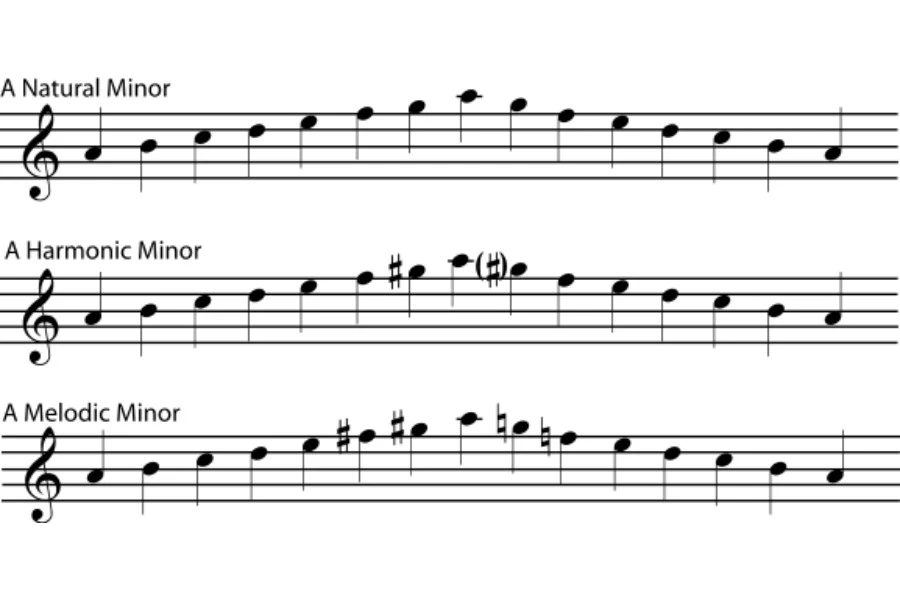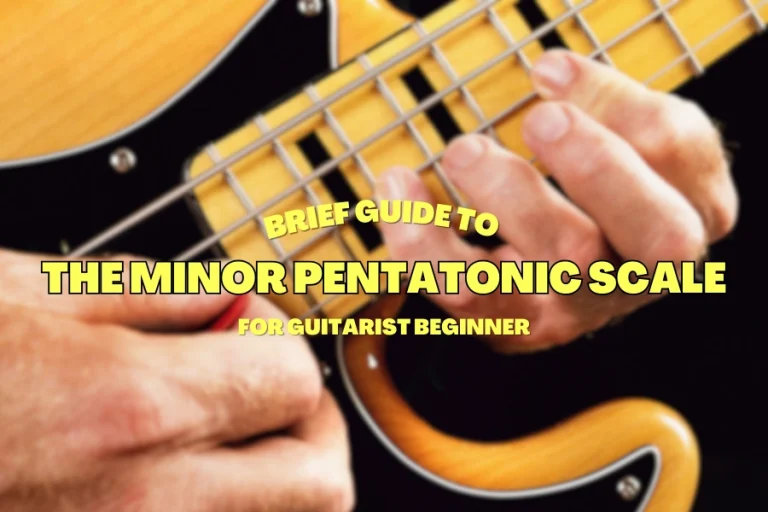
The A minor scale guitar is one of the most basic aspects of music, especially for the guitarist who seeks to enter the deeper tonalities. A minor scale is not just a set of notes but a primary tool that enables musicians to create melodies with deep, sad emotions. The natural, harmonic, and melodic minor scales are not simply variations. Each minor scale gives a unique taste to your guitar. From beginners to advanced players, who seek to diversify their repertoire, knowing the A minor scale can be very beneficial.
If you’re eager to know what a minor scales guitar is, how to play them, and different types of minor scales, spend a little time reading to understand each of the types and how they can change your guitar experience.
What is a Minor Scale Guitar?
In the world of music theory, the minor scale is a key foundation that adds depth and emotion to a piece. A minor scale is well known for being its darker, more sad tune. A minor scale is often used to create feelings of sadness, tension, or introspection. A minor scale is often used to create feelings of sadness, tension, or introspection. Unlike the bright and uplifting major scale, the minor scale allows musicians to explore a more dramatic and emotional range.
Minor scale guitar is necessary for both the composer and the performer. Because a minor scale gives composers and performers the ability to craft music that makes a connection at a deeper level, and in expressing every mood. If you’re a guitarist or any musician, learning the minor scale will open up a new way to express yourself in your music.
How to Play A Minor Scale Guitar
The A minor scale has seven notes, so you can follow and play it on the guitar.
Notes in the A Minor Scale
The A minor scale is made up of seven notes: A, B, C, D, E, F, and G. They can be thought of as intervals, as semi notes or steps on the guitar fingerboard, written as 2 – 1 – 2 – 2 – 1 -…. This A minor scale has no sharps or flats, so it’s just like a C major scale in terms of note selection. However, the key difference is that the A minor scale starts on the A note, so it’s the relative minor of C major. The same set of notes is used, but with this relationship, the A minor scale has a different sound.
Now that you know the notes on a guitar, we’ll see how to place your fingers on the fretboard to play the A minor scale.

A Minor Scale Guitar Positions
The guitar scale diagrams are one of the easiest ways to begin learning the A minor scale. These visual guides show you exactly which frets to place your fingers on and where on the fretboard of your guitar. Once you learn to read these charts, you’ll be able to understand how scales are structured and what the notes correspond to on the fretboard.
The following diagrams represent each dot as a note to be played on the fretboard. The root note, A, across the fretboard is marked with yellow dots. These markers will help you see where the scale starts over again, making it easier to memorize the patterns.
A Major Scale Guitar – Open Position
The A minor scale played in open position requires you to only play notes on the first three frets of your guitar. For notes on 1st fret, use your index finger; on 2nd fret, middle finger; on 3rd fret, ring finger. There are some notes in the scale on the 6th (low E) string, but it may be best to begin with the open A (5th string) to use the lowest possible A as the root. Then you’d go to the 2nd fret on the 5th string, B, and the 3rd fret, C.
A Major Scale Guitar – 5th Position
Another way to play the A major scale is in the 5th position. When you move up the fretboard to play these same notes in a higher register, you’ll be hearing them from a different starting position.
Let’s start with our index finger on the 5th fret of the 6th (low E) string, another A note. For the 7th fret on the same string, you’ll use your ring finger, and for the 8th fret, your pinky finger.
We just want to remind you that when you get to the 3rd string you’ll have to move your hand to the 4th fret on your index finger. When you get to the 2nd string your index finger will shift back to the 5th fret.
Notice the difference in tones and feel, playing higher up on the fretboard.
A Minor Scale Guitar Tabs
For many guitar players, tabs provide a step-by-step guide to playing scales, which can be easier to follow than scale diagrams. Diagrams help you visualize the fretboard, but tabs will teach you the exact notes and fret positions. Both methods are valuable, so it’s helpful to understand and practice using each.
We’ll take a look at the A minor scale in tab form, based on the two positions we talked about.
Open Position Tab A Minor Scale Guitar
In the open position, to play the A minor scale, you begin on the open A (5th) string and work across the fretboard. The tab below will take you through exactly which frets to play, so you can get used to the open position pattern.
5th Position Minor Scale Tab
In 5th position if you’re playing A minor scale you would be on 5th fret of low E string with your index finger. To play the scale, you follow the tab below and remember to shift to the 4th fret for the 3rd string. This shift will be smoother if your index finger acts as an anchor for this.
Types of Minor Scales & Intervals on Guitar
There are lots of different types of minor scales when you’re learning the guitar. Each one will bring a different flavor to your playing. The three most common minor scales are:

Natural Minor Scale
The simplest of the three is the natural minor scale. Natural minor scale plays the notes of a key but doesn’t change the key signature. If you want to play this scale, you start on the root note (the first note of the scale) and follow this formula of intervals:
- Whole step
- Half step
- Whole step
- Whole step
- Half step
- Whole step
- Whole step
The natural minor scale is the foundation of more advanced scales while maintaining the emotional, melancholic quality of minor scales. You need to practice this pattern over and over again until you understand the minor scale structure and improve your guitar playing skills.
Harmonic Minor Scale
The natural minor scale is a little easier than the harmonic minor scale. The harmonic minor scale unique sound comes from the raised 7th note, which adds an extra half step, creating a distinct rise in pitch as you near the top of the scale. This is the harmonic minor, more dramatic, almost classical sound. We found harmonic minor scale commonly in instruments where tension and resolution are necessary within a style.
If you want to construct the harmonic minor scale, starting from the root note, you follow this interval pattern:
- Whole step
- Half step
- Whole step
- Whole step
- Half step
- Whole step + half step
- Half step
For example, if you were playing an E natural minor scale, the 7th note would naturally be a D. However, when you play the E harmonic minor scale, you raise the D to a D#, adding that extra sharpness. The more subtle change makes the harmonic minor scale sound like a different scale, no longer as commonplace and more otherworldly and powerful.
Melodic Minor Scale
Of the three minor scales, the melodic minor scale is the most complex. The thing that makes the melodic minor scale different is that as you ascend, the 6th and 7th notes are raised by another half step. This makes the sound more smooth and flowing, which is used in jazz and classical music.
To play the melodic minor scale, starting from the root note, you follow this interval pattern:
- Whole step
- Half step
- Whole step
- Whole step
- Whole step
- Whole step + half step
- Half step
For example, if you were playing the E melodic minor scale, the 6th note would be C#, and the 7th note would be D#, both raised by a half-step. But when you descend you go back to the natural minor scale pattern, and the familiar intervals, without the raised notes. The character of the melodic minor scale is unique and dynamic because it shifts between ascending and descending.
Final Words
If you’re fascinated by the emotional depth A minor scale can bring to your guitar playing. Exploring the different types of minor scales will take your skills to the next level. All the types of the A minor scale guitar divisions natural, harmonic, and melodic are good ways of expressing oneself musically. By getting to know these scales, you will expand the possibilities of playing and add versatility to your work, which will allow you to come up with interesting melodies.









